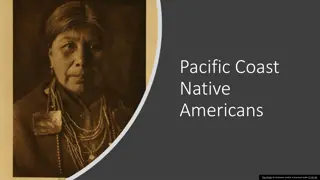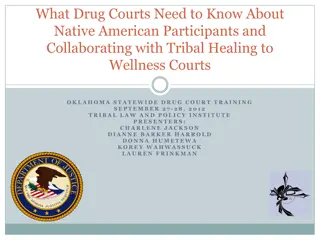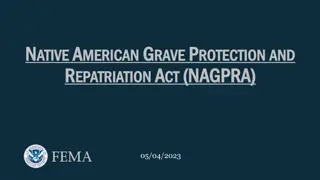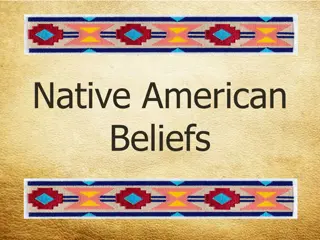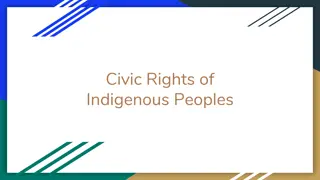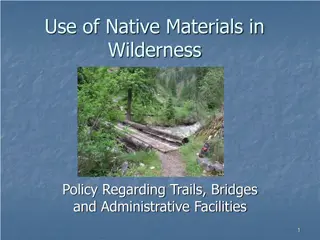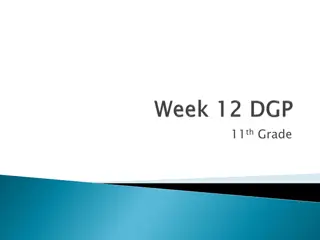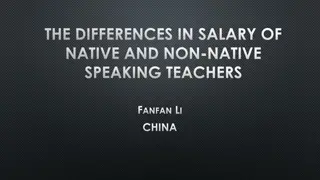
History and Struggles of Native Americans in America
Explore the historical context and struggles faced by Native Americans in America, from the myths of the Noble Savage to the harsh realities of assimilation, land allotment, and modern movements fighting for Native American rights. Learn about key events like the Indian Removal Act, General Allotment Act, and significant moments in Native American activism. Delve into the literary contributions of American women poets like Louise Erdrich, shedding light on the impact of oppression through metaphors found in Western films and drive-in theaters.
Download Presentation

Please find below an Image/Link to download the presentation.
The content on the website is provided AS IS for your information and personal use only. It may not be sold, licensed, or shared on other websites without obtaining consent from the author. If you encounter any issues during the download, it is possible that the publisher has removed the file from their server.
You are allowed to download the files provided on this website for personal or commercial use, subject to the condition that they are used lawfully. All files are the property of their respective owners.
The content on the website is provided AS IS for your information and personal use only. It may not be sold, licensed, or shared on other websites without obtaining consent from the author.
E N D
Presentation Transcript
Dr. VASILEIOS N. DELIOGLANIS AMERICAN WOMEN POETS AMERICAN WOMEN POETS OF THE 20 OF THE 20TH CENTURY CENTURY Native Americans TH& 21 & 21ST ST Department of English Language and Literature, National & Kapodistrian University of Athens
Andrew Jackson - Indian Removal Act (1830) Myth of the Indian: The Noble Savage Noble: freedom, innocence, nature, virgin land Savage: Uncivilized, non-Christian Motto in boarding schools: Kill the Indian and save the man Paradox: Americans build their national identity on Indian identity HISTORICAL CONTEXT Myth: Assimilation / Enculturation vs. Reality: Extinction The Vanishing Indian: Civilizing the Indian = corruption, destruction & cultural genocide Trail of Tears (1838)
General Allotment Act of 1887 / Dawes Act Surveyors of Indian tribal land Tribal land was divided into allotments for individual Native Americans In order to preserve this land, Indians were obliged to pay taxes to the government. Due to this policy, many Indians lost their piece of land, ending up destitute and landless, since they were not able to pay their taxes. Land Tenure Members of the selected tribe or reservation were either given permission to select pieces of land usually around 40 to 160 acres in size for themselves and their children, or the tracts were assigned by the agency superintendent surpluslands : If the amount of reservation land exceeded the amount needed for allotment, the federal government could negotiate to purchase the land from the tribes and sell it to non-Indian settlers (https://iltf.org/land-issues/history/).
1950 1950s s: : government s policy of moving them off reservations and into cities 1960 1960s s and and 1970 1970s s: : Native Americans became more aggressive in pressing for their own rights 1968 1968: : American Indian Movement (AIM) 1969 1969: : a landing party of 78 Native Americans seized Alcatraz Island in San Francisco Bay and held it until federal officials removed them in 1971 1973 1973: : AIM took over the South Dakota village of Wounded Knee 1975 1975: : Education Assistance Act 1996 1996: : Native American Housing and Self-Determination Act 1992 1992: : Senate s first Native American member elected The Native American Movement
Dear John Wayne Western film / drive-in movie theater metaphors for oppression Imperialism: ongoing cultural battle between white colonizers and Native Americans Title: John Wayne western John Wayne, aka The Duke (1907-1979): American actor / popular icon / starred in Western and war movies / one of the greatest male stars of classic American cinema https://www.youtube.com/watch?v=dc8glsGbIus&ab_channel=Movieclips https://www.youtube.com/watch?v=bKDCL-t9jng&ab_channel=PorflePopnecker Presentation title
Dear John Wayne Janice Janice Could composed of, and somehow witness to, the memories and psyches of others living and dead, and perhaps those yet to come. But more than our psyches have been affected by the political and historical events of the past five hundred years. Our lives as tribal people (even those of us who are mixed-blood) have been seized socially and demographically, and those changes have been irrevocable. Our imperative is to resurrect a history that has been buried, lost, or ignored. That history is one that has been silenced because it is the story of the people whose lives have been conquered and displaced, a story written to serve the needs of the colonizer. For American Indian women, a resurrection of writing means more than offering in the place of a master narrative an account of the dispossessed. This writing amounts almost to an act of exhumation. (1995) Could: : [M]any Indian women writers write their memories and psyches as Presentation title
Dear John Wayne Janice Janice Could of oral tradition, transliterated finally into the rhythms, structures, and techniques of contemporary verse. It is woven out of the stories we tell one another, sometimes in tears, sometimes in rage, stories collected, envisioned, and breathed into existence. (1995) Could: : Our poetry, as story and record, is part of the fabric Paula Gunn Allen: The impact of genocide in the minds of American Indian poets and writers cannot be exaggerated. It is a pervasive feature of the consciousness of every American Indian in the United States, and the poets are never unaware of it. (1986) Presentation title
Dear John Wayne Storytelling: shapes Native American cultures and societies & reestablishes lost bond with heritage, culture, language, history Language as a tool of empowerment Recollection Presentation title




